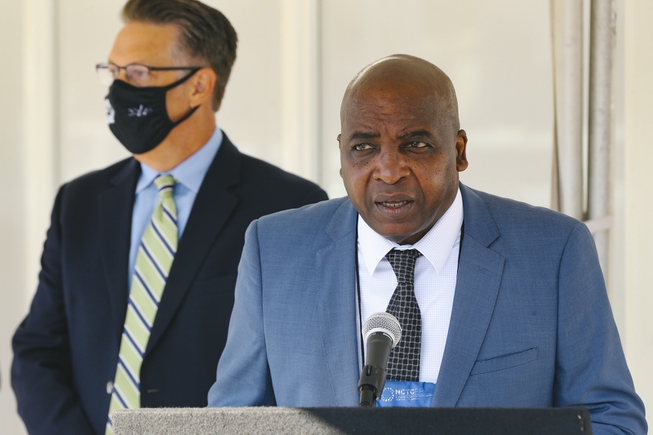
Dr. Fermin Leguen, District Health Officer, speaks outside of the Southern Nevada Health District Wednesday, Nov. 10, 2021.
Wednesday, March 29, 2023 | 1:38 p.m.
Fourteen percent of Clark County residents under the age of 65 were uninsured in 2020, and the county has historically reported high rates of uninsured individuals, according to a study released today.
The 2023 County Health Rankings released by the University of Wisconsin-Madison’s Population Health Institute ranked Clark County as the sixth-healthiest county of the 16 surveyed in Nevada.
The study used data from the past three years, finding that behavioral patterns, clinical care access, and social and economic factors are affecting the health of residents in Clark County.
The results provide insight into both the challenges faced and progress made in the county’s efforts to raise the health status of the community, said Dr. Fermin Leguen, District Health Officer of the Southern Nevada Health District.
These influencing health factors are individual areas typically created or impacted by policies and programs implemented in a region, said Dr. Benjamin Ashraf, an epidemiologist at the Health District.
“We can see, like in Southern Nevada, that some of (the individual aspects) that are health factors are a little bit on the lower end,” Ashraf said. “However, what’s important is with that knowledge, what we can do is we can enact and modify existing policies to better improve (these factors).”
The study found that while only 14% of Nevadans smoke cigarettes, 17% of Clark County residents identified as smokers in 2020.
Additionally, the county has a higher average of obese adults at 31% of the population compared with Nevada’s average of 28%. The county also surpasses Nevada’s average in physical inactivity of residents and diagnoses of sexually transmitted infections.
But it’s more than physical health; social and economic factors also play a part in a community’s overall well-being, county officials stressed. This is where Clark County seems to fall short, the survey indicates.
The county recorded an 8.3% unemployment rate compared with the state’s 7.2% in 2021.
Severe housing problems and air pollution also remain issues in the county, according to the study. About 20% of residents from 2015 to 2019 experienced at least one of four severe housing problems: high housing costs, lack of kitchen facilities, lack of plumbing facilities or overcrowding.
The rate of air pollution has actually decreased since 2018, but still leaves room for concern compared with other counties.
An annual average of 8.4 micrograms per cubic meter of fine particulate matter — such as dust and smoke — was measured in the air in 2019. While it does fall below the Environmental Protection Agency’s primary annual average standard of 12 micrograms per cubic meter, Clark County’s average was twice as high as that in the entire state.
So what does this mean for the future health and wellness of Clark County residents? To experts like Ashraf and Brandon Delise, a senior epidemiologist at the HD, it’s simply room for improvement, which will bring continued efforts in the organization’s community health projects and partnerships.
The county’s three-year Community Health Improvement Plan, known as CHIP, will provide the road map for these efforts based on data drawn from past County Health Ranking reports. Improving community health is a group effort, though.
“To enact the change that we’re hoping to see in creating a more healthy and equitable community throughout Southern Nevada, we need to enact policies and programs that are favorable towards public health,” Ashraf said.
The survey
The University of Wisconsin-Madison’s Population Health Institute began publishing county health rankings for Wisconsin in 2003, then expanded the study nationally through a partnership with the Robert Wood Johnson Foundation in 2010.
It now collects and publishes data annually from a majority of counties in all 50 states, according to the institute’s website
The study’s purpose is to “provide a revealing snapshot of how health is influenced by where we live, learn, work and play,” the website said. A different aspect that affects community health is studied each year, and the focus for 2023’s report is civic health, which the center defines as “the opportunities people have to participate in their communities.”
Civic health can encompass a number of areas, including infrastructures like schools and civic participation in activities such as volunteering or voting. Creating spaces that encourage inclusive civic participation can allegedly have a positive impact on health equity while deliberate exclusion can spell trouble for the entire community, according to the report.
One example of this benefit was the passing of the 1964 Civil Rights Act, which desegregated hospitals and led to a significant decrease in infant mortality rates among Black children from 1965 to 1971, narrowing the gap between Black and white infant mortality.
The study argues that when disenfranchised groups engage in civic participation, the actions and policies that follow typically benefit the health and well-being of everyone in the community.
“Our civic health must be nurtured,” the study said. “Our civic health depends on the decisions we make – whether we are an elected official or a local volunteer – to cultivate community conditions where everyone is welcome, lives with dignity and thrives.”
